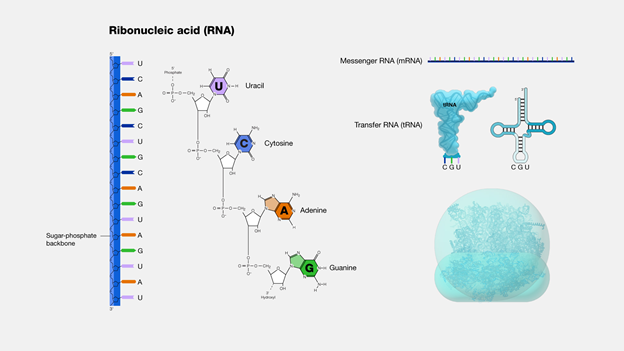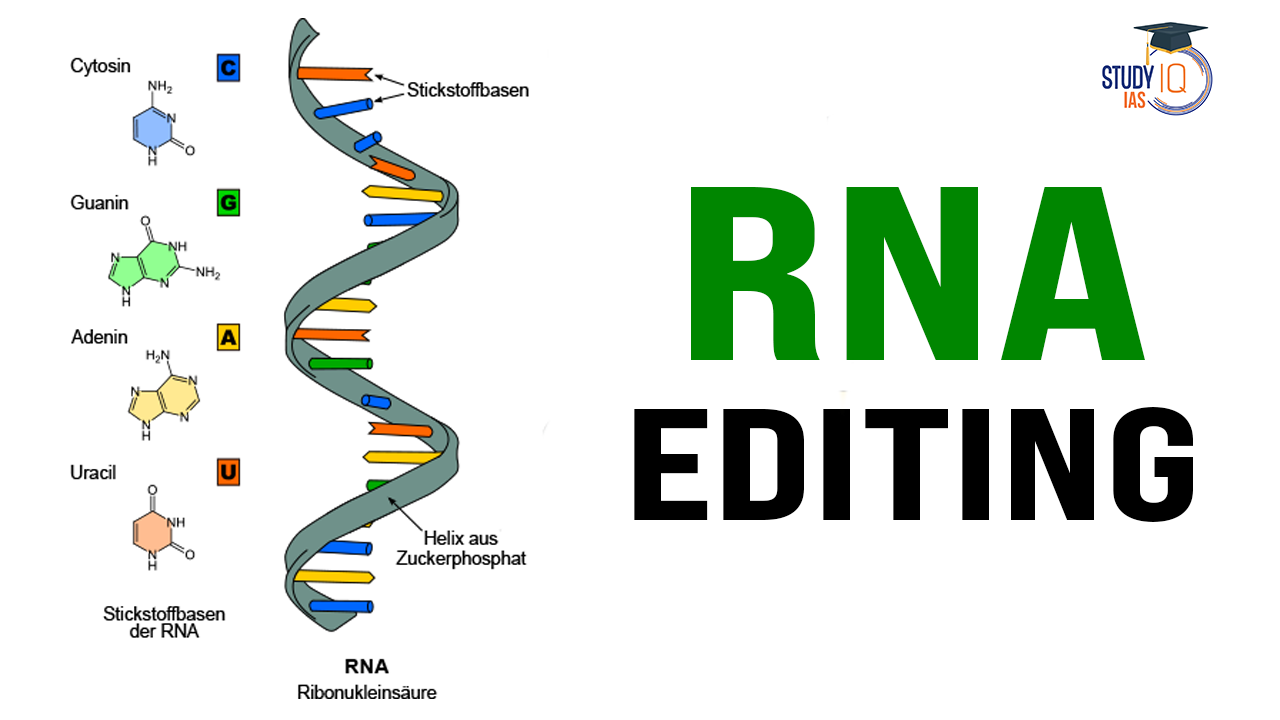Table of Contents
What is RNA?
- Ribonucleic acid (RNA) is a molecule found in almost all living things and viruses. It’s made of smaller units called nucleotides, each with three parts: a sugar (ribose), a nitrogen base, and a phosphate group.
- The nitrogen bases in RNA are adenine, guanine, cytosine, and uracil.
- The most recognized function of RNA is its role in protein synthesis, which follows the central dogma of molecular biology: DNA → RNA → Protein.

- This process involves several types of RNA:
- Messenger RNA (mRNA): This type carries genetic information from DNA to the ribosomes, where proteins are synthesised.
- mRNA serves as a template that dictates the amino acid sequence of the protein being formed.
- Transfer RNA (tRNA): tRNA transports specific amino acids to the ribosome during protein synthesis.
- Each tRNA molecule recognizes a specific codon on the mRNA and brings the corresponding amino acid, facilitating the assembly of proteins.
- Ribosomal RNA (rRNA): rRNA is a structural component of ribosomes, which are the cellular machinery that synthesise proteins.
- It plays a critical role in ensuring proper alignment of mRNA and tRNA during translation and catalyses the formation of peptide bonds between amino acids
- Messenger RNA (mRNA): This type carries genetic information from DNA to the ribosomes, where proteins are synthesised.
What is RNA Editing?
- RNA editing is a technique that lets scientists fix errors in a cell’s RNA to make sure the right proteins are produced.
- Cells follow instructions from DNA to make messenger RNA (mRNA), which then guides the making of proteins.
- But sometimes, mistakes slip into mRNA, which can lead to incorrect or harmful proteins. Faulty proteins can cause serious diseases.
- RNA editing provides a way to correct these mistakes in the mRNA before the cell uses it to make proteins.
How Does RNA Editing Work?
- Substitution Editing: In this type of editing, certain nucleotides in the RNA are changed into different nucleotides.
- For example, an adenosine (A) can be converted into inosine (I) by enzymes known as adenosine deaminases (ADARs).
- Inosine behaves like guanosine (G) during protein synthesis, effectively correcting potential mistakes in the mRNA sequence.
- Insertion/Deletion Editing: This involves adding or removing nucleotides from the RNA sequence.
- This type of editing often requires a guiding RNA (gRNA) that directs the editing enzymes to the specific location on the mRNA where changes need to be made.
- For instance, uridine nucleotides can be added to the mRNA based on the complementary sequence provided by the gRNA.
The Role of ADAR Enzymes
ADAR enzymes play a significant role in RNA editing:
- They bind to double-stranded regions of RNA and catalyse the conversion of adenosine to inosine.
- By changing A to I, ADARs alter how the RNA is read during translation, potentially changing which amino acids are incorporated into proteins.
Applications of RNA Editing
Scientists are developing RNA editing treatments for several diseases caused by genetic mutations:
- Alpha-1 Antitrypsin Deficiency (AATD): A condition where a protein called alpha-1 antitrypsin builds up in the liver and lungs, harming these organs. A company called Wave Life Sciences developed a therapy (WVE-006) using RNA editing to fix single-point mutations in the gene for alpha-1 antitrypsin.
- By correcting this error, the cell can produce normal protein levels, potentially eliminating the need for liver transplants or weekly treatments.
- Expanding Treatment Options: Wave Life Sciences is also testing RNA editing for diseases like Huntington’s disease, Duchenne muscular dystrophy, and some types of obesity, which all involve single-point mutations that RNA editing could potentially fix.
- Other Companies in RNA Editing:
- Korro Bio is using ADAR enzymes for AATD and Parkinson’s disease.
- ProQR Therapeutics focuses on RNA editing for heart disease and liver issues.
- Shape Therapeutics is exploring RNA editing for neurological conditions.
These companies use various delivery methods and guides to improve RNA editing.
- Editing Larger Genes: For genes too large to replace with traditional gene therapy, like ABCA4 (linked to a retinal disease), RNA editing may help.
- Ascidian Therapeutic is testing this approach for retinopathy, a serious eye condition. Its candidate started clinical trials in early 2024, receiving fast-track approval from the U.S. Food and Drug Administration.
- Cancer Treatment: The South Korean company Rznomics is trialling an RNA editing treatment for certain liver cancers. This approach controls a protein, human telomerase reverse transcriptase, which can influence tumour growth.
| RNA vs. DNA Editing |
RNA Editing
DNA Editing
|
What are the Challenges Associated With RNA Editing?
- Specificity Issues: ADAR enzymes may perform edits on both targeted and non-targeted mRNA regions, or they may skip the targeted area altogether, which can lead to unintended side effects.
- Current efforts are focused on improving the precision of guide RNA (gRNA) by adding mechanisms to protect non-targeted mRNA parts from accidental edits.
- Transient Nature of RNA Editing: RNA editing is temporary, so individuals may require repeated treatments to maintain therapeutic effects.
- Delivery Limitations: The delivery systems, such as lipid nanoparticles and adeno-associated virus (AAV) vectors, have limited capacity, making it difficult to transport large molecules effectively.
Future Outlook
- RNA editing is in its nascent stage, yet there are already at least 11 biotechnology companies worldwide developing RNA editing methods for a range of diseases.
- As research and clinical trials advance in the field of RNA editing, it seems like only a matter of time before RNA editing becomes a fixture of the gene-editing toolkit in clinical practice.


 NASA Parker Solar Probe Flies Closer to ...
NASA Parker Solar Probe Flies Closer to ...
 Silvaguard Drone, Purpose and Working Me...
Silvaguard Drone, Purpose and Working Me...
 India’s Deep Sea Technology, Need and ...
India’s Deep Sea Technology, Need and ...





















